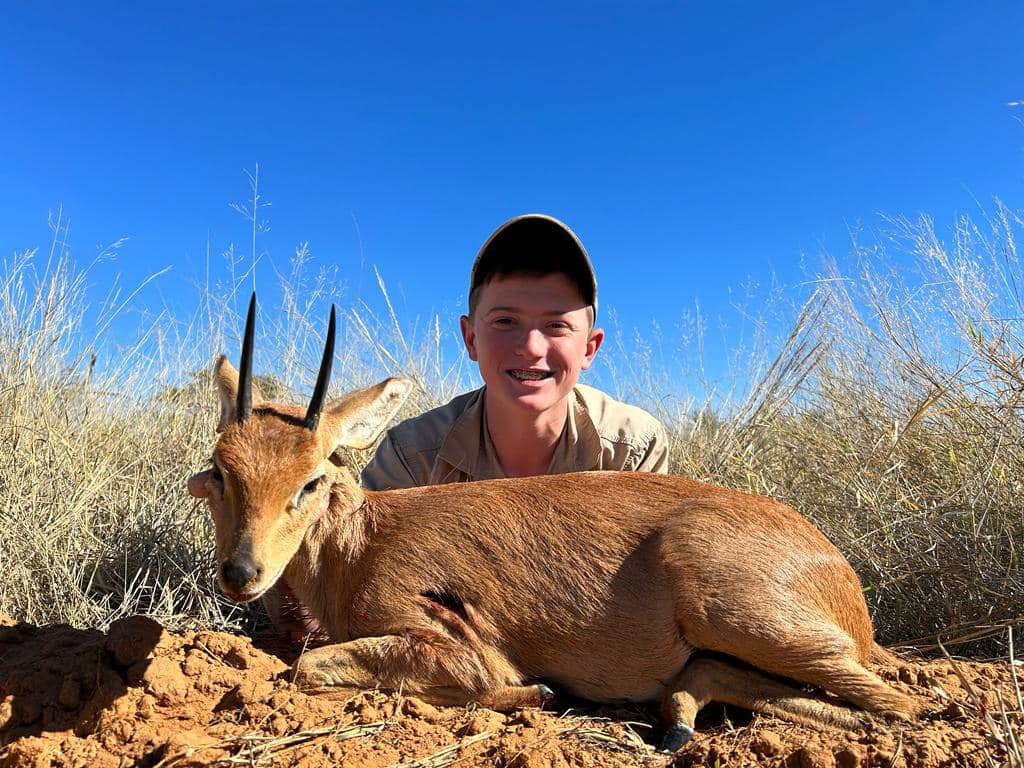When most hunters think of African safaris, the first animals that come to mind are the members of the Dangerous Seven. This includes Lion, Leopard, Rhino, Elephant, Crocodile, Hippo, and, of course, Africa’s Black Death … the Cape Buffalo. Big spiral-horned antelopes are also closely associated with African safaris and include numerous antelopes, such as the Eland, Kudu, Bongo, and Nyala.
Dangerous game hunting receives more international press coverage due to conservation news on rhino/elephant poaching and human deaths caused by these animals. It is not widely known that the Tiny Ten is a group of antelopes trophy hunters lust over, quickly becoming obsessed with adding mature rams to their trophy rooms. They grow on the hunter who decides to start hunting them and tests their skill, wit, and sheer determination. These animals are mostly found in Southern Africa but are also endemic to a few other countries.
Challenges of Hunting the Tiny Ten
The Damara Dik-Dik can be hunted in Namibia, while the Suni are targeted in Mozambique. The rest of the Tiny Ten game antelopes are hunted throughout Southern Africa.
Is it possible to Hunt the Tiny Ten on a Single Safari?
Best Time for Hunting the Tiny Ten
Tips for Hunting the Tiny Ten
- Practice your shooting skills and develop the load.
- Accuracy is critical, and the target is small. A game hunting safari is not the time to practice your skills.
- Make sure you pack the legal amount of ammunition and check limits when crossing African borders.
- It would also be advisable to make use of a caliber that is available in African countries. It would be a pity to have only two species of the Tiny Ten left and run out of ammunition.
- Be Patient. Everything in Africa happens at its own pace. Trying to rush a situation is only going to lead to disappointment.
- Hunting the Tiny Ten is a challenge requiring persistence and patience. Waiting can take many hours as these Tiny Ten antelopes are masters of camouflage and know their habitats better than the hunter.
- Be Alert. These animals are quick and ever-alert when it comes to potential threats. Your moment may only be a few seconds. If you lose this opportunity, you will be looking at booking another safari to complete your collection.
Frequently Asked Questions
What is South Africa’s Smallest Antelope?
How Can I Prepare for Tiny Ten Hunting?
- When preparing for a Tiny Ten hunt, prepare physically and mentally. Good physical shape for miles of hiking and mentally prepared to spend many hours waiting for the perfect shot.
- When planning and packing for your safari, ensure nothing is forgotten. A dream African safari can be ruined by forgetting medical supplies, paperwork, and key safari items. Hunting in Africa can take the hunter to the most remote and scenic places where, unfortunately, retail outlets are not within arm’s reach.
- Another item for consideration is a satellite phone, as not all of Africa has cell and data reception.
- Work with only top-rated outfitters and guides, and ensure that you obtain references before confirming and paying deposits. A hunting safari broker can be consulted.
What is the Best Caliber for the Tiny Ten?
How Much Does it Cost to Hunt the Tiny Ten?
While trophy prices may vary between outfitters, the chart below indicates the average prices when writing this article.
- Blue Duiker – US $2,100
- Red Duiker – US $2,500
- Common Duiker – US $500
- Cape Grysbuck – US $2,100
- Suni – US $3,400
- Steenbok – US $700
- Oribi – US $2,900
- Klipspringer – US $1,800
- Damara Dik-Dik – US $3,500
- Sharpe’s Grysbok – US $3,900
Can the Tiny Ten be hunted when Hunting Dangerous Game?
- Yes, you can add Tiny Ten antelopes to a dangerous game safari in Africa. Many times when the hunter is on an African safari hunting nocturnal species like lion, leopard, and hyena, the hunter spends his days checking baits or enjoying the African hospitality.
- A suggestion is to hunt these African plains game a distance from the baited area, as they share the same habitat as the larger game animals.
How do you measure the minimum SCI score?
Shot Placement for the Tiny Ten
Facts about the Tiny Ten
Blue Duiker (Philantomba monticola)

- The Blue Duiker is the world’s smallest antelope after The Royal Antelope, found in the forests of Ghana to Sierra Leone.
- Blue Duikers are listed as a species of “least concern” by the IUCN.
- Their body length ranges from between 21-31 inches.
- Females are larger than males and weigh up to a whopping 10 pounds.
- Blue Duikers, being browsers, forage on leaves but will also eat fruit, berries, flowers, and sometimes even insects.
- Blue Duikers inhabit the central, eastern, and southern regions of Africa.
- Blue Duikers are hunted from blinds, artificial waterholes, and spot and stalk.
- The Safari Club International minimum for a Blue Duiker is four and ¼ inches.
- Interesting Fact: Blue Duikers get their name from the Afrikaans words “duiker” which means to dive.
- They are one of the only Tiny Ten antelopes known to eat carrion.
Red Duiker (Cephalophus natalensis)

Photo: Rufus46 - Also known as the Natal Red Duiker and is larger than the Blue Duiker.
- It has a body length of 27-31 inches.
- Female Red Duikers tend to be smaller than their male counterparts.
- Horns have heavily ringed bases, with both sexes being tawny red.
- The Red Duiker is almost exclusively diurnal with activity peaking just after dawn and before sunset.
- Red Duikers are usually solitary antelope feeding on leaves, fruits, seeds, and flowers and can inhabit the coastal forests of Southern Africa.
- The Safari Club International minimum for a Red Duiker is eight inches.
- Interesting Fact: Red Duikers supplement their diets with meat.
Common Duiker (Sylvicapra grimmia)
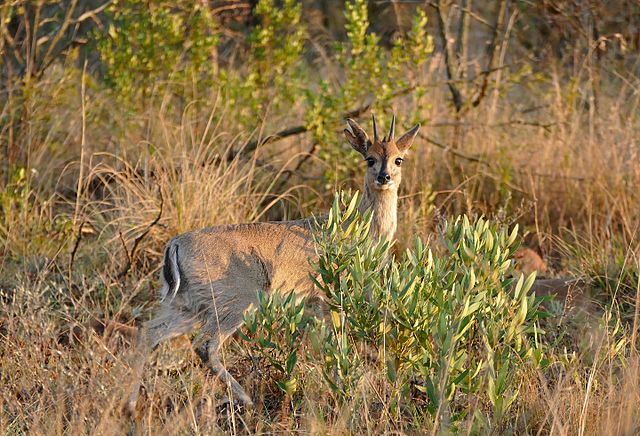
- Only the males (rams) have small, short horns, and their habitat is widely distributed in Southern Africa except for the desert regions.
- Common Duikers avoid open grassland where there is no shelter from predators.
- Common Duikers are the most common African plains game.
- There are sixteen different subspecies recorded throughout Africa.
- Males can weigh up to forty-five pounds and fight when their territory is invaded.
- The Safari Club International minimum for a Common Duiker is eleven inches.
- Interesting Fact: Common Duikers are also known as Gray Duiker or Bush Duiker and are the only members of the genus Sylvicapra.
- Common Duiker, following in the traditions of their Blue and Red “cousins”, supplement their diet with meat.
Cape Grysbuck (Raphicerus melanotis)

- The Cape Grysbuck, also known as the Southern Grysbuck inhabits the Western Cape region of South Africa.
- The Cape Grysbuck is endemic to the Fynbos Biome.
- When hunting for this Tiny Ten antelope, schedule a time to visit Table Mountain and the Cape Winelands. South Africa has a history of wine-making dating back to 1659, with the first bottle produced by its founder and Governor, Jan van Riebeek.
- The Cape Grysbuck is regarded by wine farmers as a problem animal as they cause extensive damage to grape vines.
- Cape Grysbuck are often illegally hunted using hounds.
- Only males have horns with a slight curve to the front. Both sexes are shy, nocturnal, and very rarely seen.
- Game hunting a Cape Grysbuck at night using lights.
- The Safari Club International minimum for a Cape Grysbuck is 5 inches.
- Interesting Fact: The Cape Grysbuck are extremely aggressive and will defend their territories against intruders.
Suni (Nesotragus moschatus)
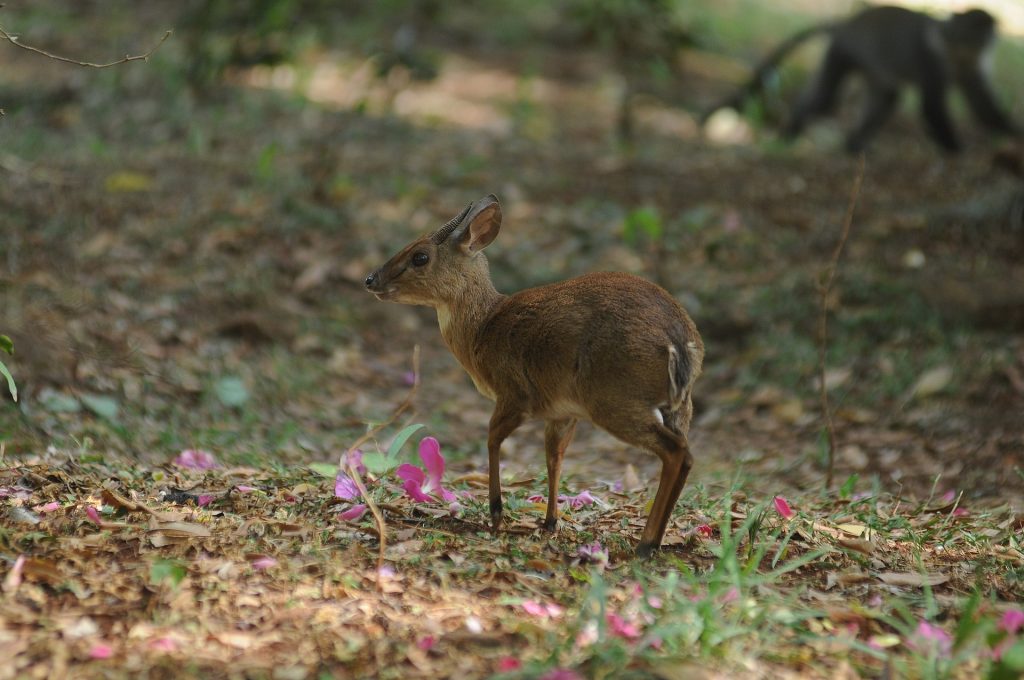
- The beautiful Suni antelope lives in the south-eastern parts of Africa in dense underbrush.
- They barely need water, are browsers, and feed on flowers, fruits, and fungi.
- Suni are reddish brown with darker colors on their backs.
- Suni can weigh up to a whopping 9.5 pounds with a body length of 22.4-24.2 inches. Only the males have short, spike-like horns set wide on the skull.
- Suni are nocturnal but do spend time during daylight hours in heavily shaded areas.
- They regularly use pathways that run through their territories, and sleeping spots are frequently reused.
- The Safari Club International minimum for a Suni is nine inches.
- Interesting Fact: The Suni males mark their home ranges with dung middens and secretions from large pre-orbital glands.
- Suni tends to freeze in a set position if a threat is detected.
Steenbok (Raphicerus Campestris)
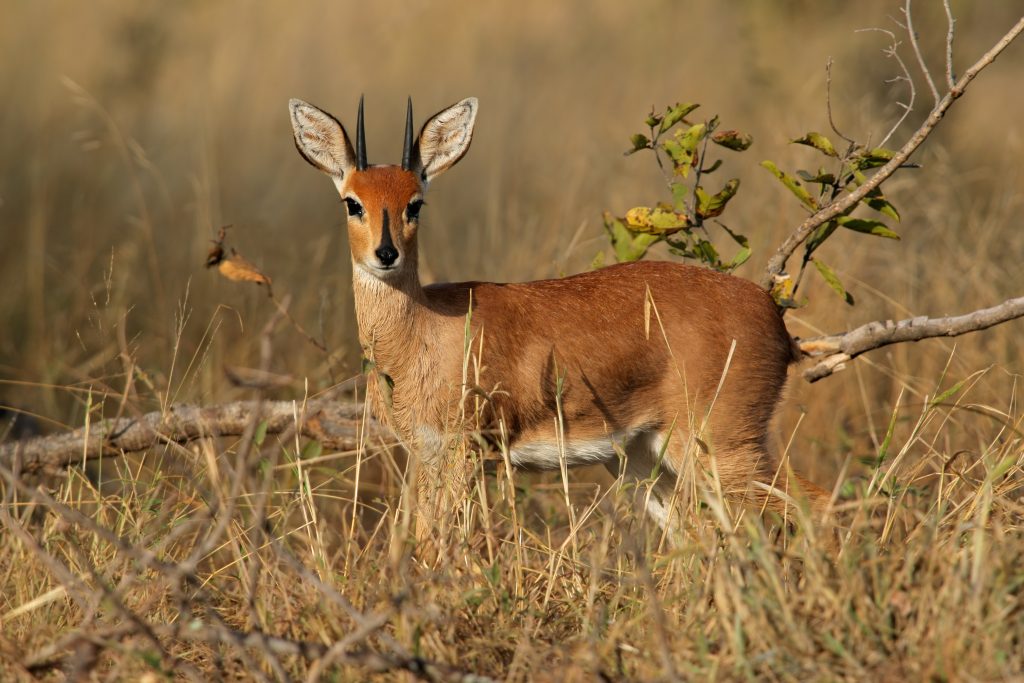
- Steenbok are the most abundant members of the Tiny Ten antelopes and are found across southern Africa, from semi-deserts to woodlands and thickets.
- Steenbok are members of the dwarf antelope family.
- I love their huge ears. They are petite antelope with an upright stance.
- Steenbok lay down in the long grasses to avoid being spotted and can run off at great speed.
- Should a Steenbok “spook,” the hunter needs to follow the antelope through his sights, as often the antelope will stop and quickly glance back. This will be the hunter’s last chance to take a shot before it literally disappears into the vegetation.
- Only the males have horns and can weigh up to 35 pounds.
- The Safari Club International minimum for a Steenbok is eight inches.
- Interesting Fact: The Steenbok derives its name from the Afrikaans word “steen” meaning stone due to its brick-red coloration. The steenbok is adored worldwide because it is so cute and small.
Oribi (Ourebia ourebi)
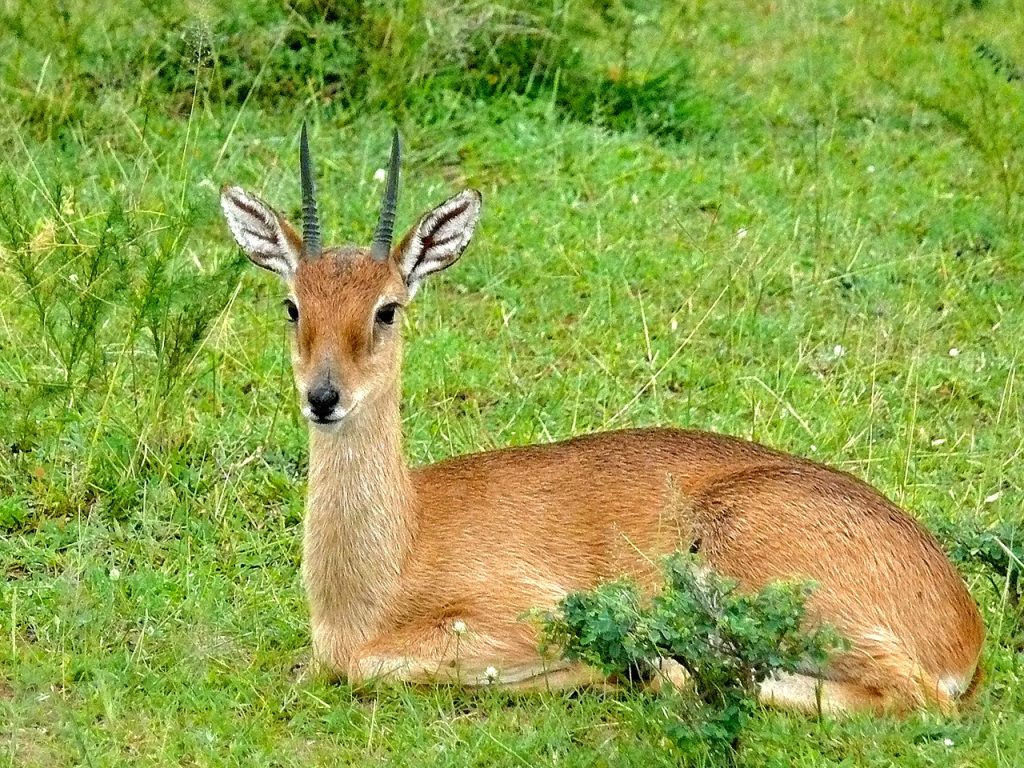
- The Oribi is the sole member of its genus, placed under the family Bovidae.
- They have long and lean necks with a light rust-brown coloring.
- Only the males have horns which are spiky and slightly curved horns to the front.
- The Oribi is widely distributed in southern Africa and found in many countries such as South Africa, Zambia, Botswana, Mozambique, and Namibia.
- They can run off at speeds in a zig-zag pattern of up to 25-30 miles per hour.
- The Oribi are highly inquisitive and, after running a distance, will often stop and look back. They may also walk back, making them an easy antelope to hunt.
- Oribi can weigh anything from 26-48 pounds.
- The Safari Club International minimum for an Oribi is 13 inches.
- Interesting Fact: The Oribi are water-independent. It gains sufficient water from all the leaves, grass, and flowers it consumes.
Klipspringer (Oreotragus oreotragus)
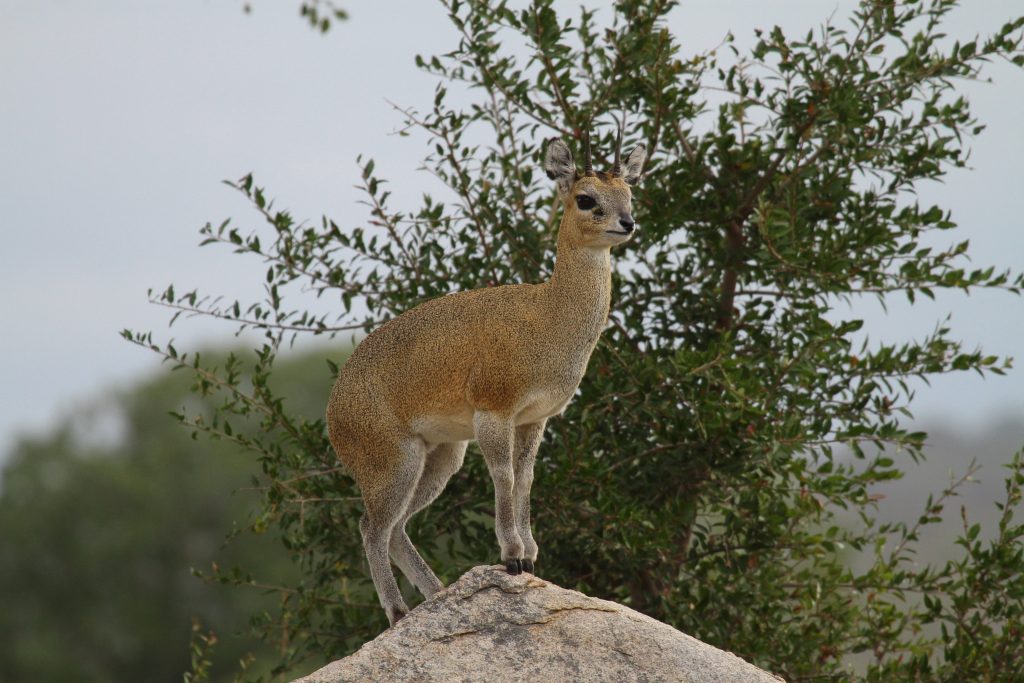
- Klipspringer are found in the eastern, northern, and southern parts of the African continent and are also known as “Klipbok,” meaning “rock jumper” in English.
- Klipspringers are water-independent and can weigh up to 40 pounds.
- Their preferred habitats are mountainous and rocky areas.
- They are rare and are often mistaken for baby antelope.
- Adult Klipspringers form monogamous pairs and are never more than 6 yards apart.
- The ewes are slightly larger than the rams, and only the Klipspringers rams have horns.
- Klipspringers have a short neck, large hindquarters, and hair filled with air, and fascinatingly enough, the Klipspringer can stand on its tiptoes.
- Klipspringers are most active in the hours of the early morning and late afternoon.
- The Safari Club International minimum for a Klipspringer is 10 inches.
- Interesting Fact: When it comes to a Klipspringer’s hoof, they are only the size of a dime. These delicate little hooves are adapted for traction on rocky surfaces and designed with a slight suction-cup effect.
Damara Dik-Dik (Madoqua kirkii)

- The Damara Dik-Dik is endemic to Namibia and is also known as the Kirk’s Dik-Dik. Luckily for plains game hunters, Namibia is a top international hunting destination.
- The Damara Dik-Dik is also a dwarf antelope, tiny and adorable, and weighs only eleven pounds.
- Their small size makes them easy picking for predators, and they get their name from the sound they make when alarmed.
- Damara Dik-Diks are also ruminants and “chew their cud.”
- They inhabit many semi-desert lands and are also water-independent.
- Males Dik-Diks are smaller and lighter than females, and like in so many other Tiny Ten game species, only the males have horns.
- Damara Dik-Diks live in pairs in small territories with established game trails and runways.
- The Safari Club International the minimum for a Damara Dik-Dik is eight inches.
- Interesting Fact: The Damara Dik-Dik uses a tar-like substance from their eye glands to mark their territory.
Sharpe’s Grysbok (Raphicerus Sharpie)

- The Sharpe’s Grysbok is a shy, secretive, and solitary member of the Tiny Ten found from tropical to south-eastern Africa.
- Only the males have short stubby horns widely placed on the skull.
- Large males can weigh 25 pounds.
- Sharpe’s Grysbok are nocturnal feeders and may spend time during the day in protective tall grass or shrubs.
- Hunting Sharpe’s Grysbok will be done at night, but the hunter may have a chance during the early hours of daybreak if they are already in position before the sun rises.
- Sharpe’s Grysbok is an extremely timid antelope and will run at the first sign of anything unusual. They will be gone from the hunter’s view in an instant.
- Their habitat is rocky hill country, but they prefer woodland areas with low-growing scrub.
- The Safari Club International minimum for a Sharpe’s Grysbok is five inches.
- Interesting Fact: The Sharpe’s Grysbok often hides from predators in Aardvark burrows (one of the four species of Hyena).
Hunting the Tiny Ten is a challenge not all African big game or plains game hunters can achieve. These little antelopes are elusive, widely spread, and have all the skills to stay alive in harsh conditions. Hunters pursuing the Tiny Ten require a high level of skill, persistence, patience, and intimate knowledge that will result in success and unforgettable safaris throughout Africa.s

